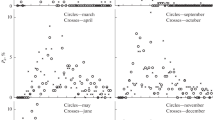Abstract
The System of Ionosphere Monitoring and Prediction (SIMP-1), an empirical model of the monthly median state of the ionosphere, includes several blocks for a global description of the ionosphere in the D and E regions and F1 and F2 layers. In this paper, the principles of the creation of the block of the foF2 monthly medians over the Northern Hemisphere, including local models of foF2 based on data from groundbased ionospheric sounding stations and the multiquadric method of mapping, are described. It is shown that the use of effective ionospheric indices of solar activity, rather than the traditionally used sunspot number R 12 makes it possible to increase the accuracy of the approximated dependence of foF2 median values on the solar activity level. The local foF2 models are created in the form of a function of the ionospheric index T over 75 stations of the Northern Hemisphere for 12 months of the year and 24 moments of Universal Time. The multiquadric method, which enables the recovery of a surface exactly through foF2 values at the given station, is used for the foF2 mapping. A comparison of the SIMP-1 model with the CCIR, Prognoz MPCh, and SMI-88 (which is an ionospheric standard in RF) is performed. It is shown that the local models show a high accuracy of approximation of the foF2 observed variations, whereas the multiquadric method provides, on the whole, a higher accuracy of description of the foF2 planetary distribution. The results confirm the high efficiency of the proposed approach.
Similar content being viewed by others
References
Bilitza, D., Altadill, D., Zhang, Y., et al., The international reference ionosphere 2012—a model of international collaboration, J. Space Weather Space Clim., 2014, vol. 4, no. A07. doi 10.1051/swsc/2014004
Caruana, J., The IPS monthly T index, in Solar–Terrestrial Predictions, Proceedings of a Workshop at Leura, Australia, October 16–20, 1989, 1990, vol. 2, pp. 257–263.
Chasovitin, Yu.K., Shirochkov, A.V., Besprozvannaya, A.S., et al., Global empirical model of the distribution of concentration, temperature, and effective collision rate of electrons in the ionosphere, Ionos. Issled., 1988, no. 44, pp. 6–13.
Chernyshev, O.V. and Vasil’eva, T.N., Prognoz maksimal’no primenimykh chastot (Forecast of Maximally Applicable Frequencies), Moscow: Nauka, 1975.
Dvinskikh, N.I. and Naidenova, N.E., Construction of ionospheric disturbance maps, in Issledovaniya po geomagnetizmu, aeronomii i fizike Solntsa (Studies on Geomagnetism, Aeronomy, and Solar Physics), 1971, no. 18, pp. 129–135.
Fox, M.W. and McNamara, L.F., Improved empirical world maps of foF2. 1. The method, 1986, Tech. Rep., IPS-TR-86-03.
GOST 25645.146-89—The Earth’s ionosphere. Model of global distribution of concentration, temperature, and effective collision rate of electrons, Moscow: Izdatel’stvo standartov, 1990.
Hardy, R.L., Multiquadric equations of topography and other irregular surfaces, J. Geophys. Res., 1971, vol. 67, no. 8, pp. 1905–1915.
Jones, W.B. and Gallet, R.M., Representation of diurnal and geographic variations of ionospheric data by numerical methods, ITU Telecom. J., 1962, vol. 29, pp. 129–149.
Journel, A.G. and Huijbregst, C.J., Mining Geostatistics, New York: Academic Press, 1978.
Mikhailov, A.V. and Mikhailov, V.V., Indices for monthly median foF2 and M(3000)F2 modeling and long-term prediction: Ionospheric index MF2, Int. J. Geomagn. Aeron., 1999, vol. 1, no. 2, pp. 141–151.
Rawer, K., Actual problems with ionospheric mapping, Indian J. Radio Space Phys., 1987, vol. 16, no. 6, pp. 373–379.
Rush, C.M., PoKempner, M., Anderson, D.N., et al., Maps of foF2 derived from observations and theoretical data, Radio Sci., 1984, vol. 19, no. 4, pp. 1083–1097.
Terekhin, Yu.L. and Mikhailov, A.V., A new approach to solving the problem of spatial approximation of observed foF2 fields, Geomagn. Aeron., 1992, vol. 32, no. 2, pp. 60–67.
Turner, J.F., The development of the ionospheric index T, IPS Series R Report R11, June 1968.
Wilkinson, P.J., Making the most out of ionospheric indices, in Proceedings of URSI Conference, Lille, 1986.
Author information
Authors and Affiliations
Corresponding author
Additional information
Original Russian Text © T.Yu. Leshchinskaya, V.V. Mikhailov, 2016, published in Geomagnetizm i Aeronomiya, 2016, Vol. 56, No. 6, pp. 772–780.
Rights and permissions
About this article
Cite this article
Leshchinskaya, T.Y., Mikhailov, V.V. SIMP-1 model: Mapping of fo F2 monthly medians over the Northern Hemisphere. Geomagn. Aeron. 56, 733–741 (2016). https://doi.org/10.1134/S0016793216060116
Received:
Published:
Issue Date:
DOI: https://doi.org/10.1134/S0016793216060116




